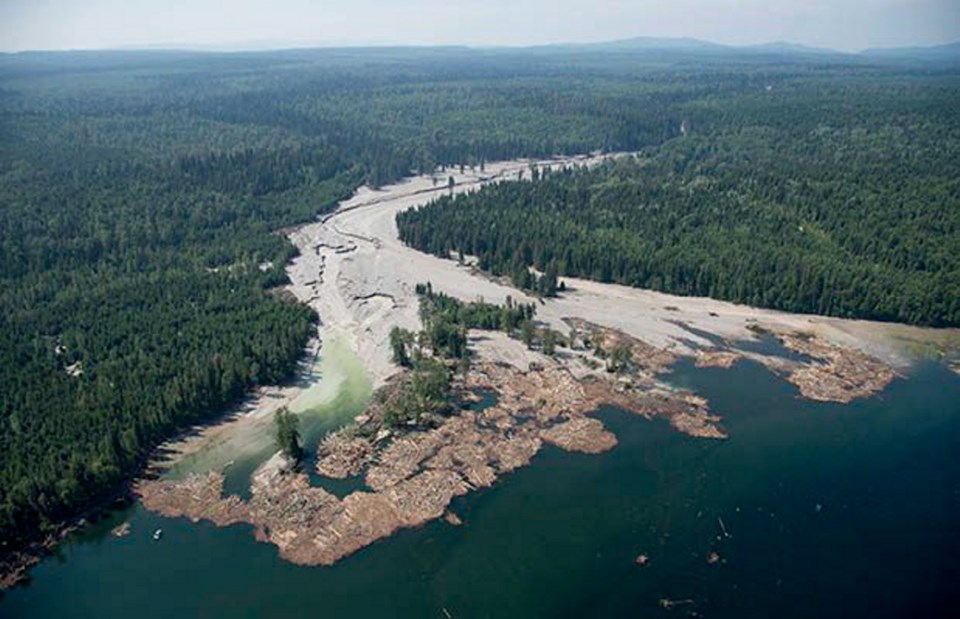Imperial Metals has broken its silence over a “tension” crack and other concerns found in a 2010 dam inspection at its Mount Polley gold and copper mine.
The company says the concerns were addressed under an engineer’s direction.
Initially the company had refused to comment on the dam inspection report obtained by The Vancouver Sun because of ongoing investigations, but last Friday it quietly posted a statement on its website.
The crack was discovered in the perimeter wall, the same embankment where a section failed on Aug. 4 this year, releasing millions of cubic metres of water and tailings containing potentially-toxic metals in Quesnel Lake.
In its statement, Imperial Metals said the crack was 900 metres from the breach, and it was subject to a series of recommendations by the engineer of record, including a stability assessment in 2011, which were fully complied with by the company under the direction of the engineer.
“After carrying out the recommended measures, (Mount Polley Mining Corp.) received no indication that there remained any issues of concern,” said the statement.
Imperial Metals declined Sunday to make anyone available for an interview or provide subsequent inspection reports to back up their statement.
In an email, Imperial Metals vice-president of corporate affairs Steve Robertson reiterated the company would not comment during the investigation, despite the fact it had commented via its website statement.
Imperial Metals did not name its geotechnical engineer in the statement, but AMEC took over as engineer of record for dam inspections between 2011-2013.
AMEC declined to comment on Sunday, also saying it will not comment during investigations.
The engineering firm that produced the 2010 report, Knight Piesold, had said the 10 to 15-metre long tension crack in the earthen dam did “not necessarily indicate a plane of weakness in fill materials but it can’t be ignored either.”
Noting that all the details into the collapse will not be known until investigations are complete, B.C. Mines Minister Bill Bennett said Sunday his understanding is that the company addressed the issues raised in the 2010 dam safety inspection report.
The mines ministry had also declined earlier to comment on whether the concerns had been addressed.
The ministry continued to decline to release dam inspection reports by the company — required under B.C. law — or its own inspection reports.
Bennett said he’s been advised by the B.C. Attorney General’s office that releasing documents could jeopardize investigations.
Investigations are being carried out by the B.C. Conservation Service, the province’s chief inspector of mines and a three-person expert panel appointed by the B.C. government.
Other concerns raised in the 2010 dam safety inspection report included that 40 per cent of 92 instruments that measure water pressure in the dam were broken and needed to be replaced before the height of the dam was raised. The height of the dam is raised on an almost continual basis to contain rising levels of water and tailings.
Replacing the instruments, called piezometers, had already been identified as an issue in 2006 during a more detailed dam safety review conducted by engineering firm AMEC.
Imperial Metals’ statement said it installed 23 new piezometers in 2011. That would have restored nearly two thirds of the approximately 36 broken instruments.
The 2010 dam safety inspection report also raised a concern over a buttress for the dam meant to be constructed along its entire length that was only constructed on the west side.
A stability analysis in 2011 determined that no additional buttress was required, said Imperial Metals’ statement. Analysis in 2012 by its engineer again showed that no additional buttress was required, but a buttress was completed along the main embankment in 2013 as recommended by its engineer, said the statement.
The 2010 dam safety report noted the company had continuing problems with creating tailings beaches in the storage facility, formed when tailings are deposited at the embankment. Knight Piesold noted the Ministry of Energy and Mines had identified this as a “deficiency” in a 2008 geotechnical inspection. The beach is considered an important buffer between the dam’s embankment and water in the pond.
Since the 2010 report, Mount Polley has enhanced its system to provide more tailings to all locations around the dam, said the company’s statement.



